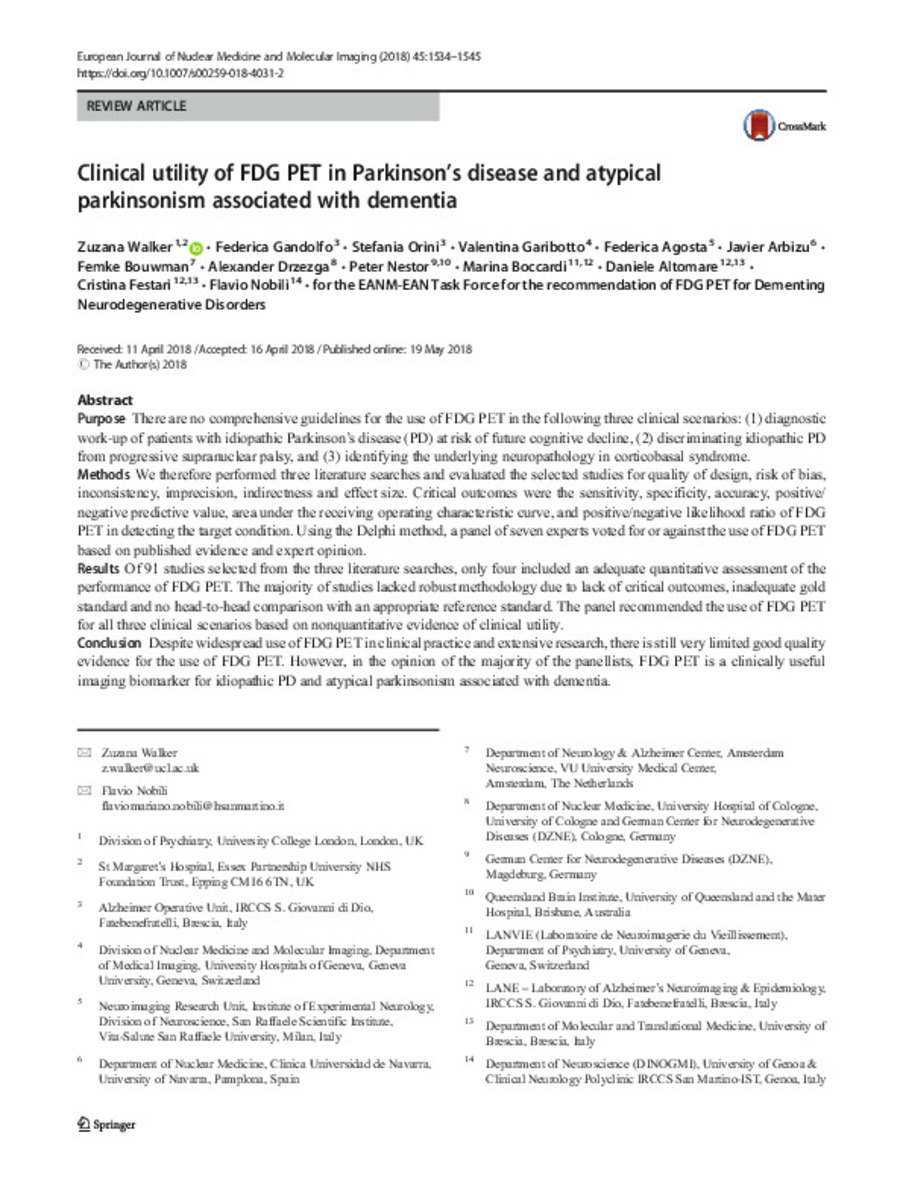Full metadata record
| DC Field | Value | Language |
|---|---|---|
| dc.creator | Walker, Z. (Zuzana) | - |
| dc.creator | Gandolfo, F. (Federica) | - |
| dc.creator | Orini, S. (Stefania) | - |
| dc.creator | Garibotto, V. (V.) | - |
| dc.creator | Agosta, F. (Federica) | - |
| dc.creator | Arbizu, J. (Javier) | - |
| dc.creator | Bouwman, F. (Femke) | - |
| dc.creator | Drzezga, A. (Alexander) | - |
| dc.creator | Nestor, P. (Peter) | - |
| dc.creator | Boccardi, M. (Marina) | - |
| dc.creator | Altomare, D. (Daniele) | - |
| dc.creator | Festari, C. (Cristina) | - |
| dc.creator | Nobili, F. (Flavio) | - |
| dc.date.accessioned | 2023-04-05T11:38:55Z | - |
| dc.date.available | 2023-04-05T11:38:55Z | - |
| dc.date.issued | 2018 | - |
| dc.identifier.citation | Walker, Z. (Zuzana); Gandolfo, F. (Federica); Orini, S. (Stefania); et al. "Clinical utility of FDG PET in Parkinson's disease and atypical parkinsonism associated with dementia". European journal of nuclear medicine and molecular imaging. 45 (9), 2018, 1534 - 1545 | es |
| dc.identifier.issn | 1619-7070 | - |
| dc.identifier.uri | https://hdl.handle.net/10171/65872 | - |
| dc.description.abstract | Purpose There are no comprehensive guidelines for the use of FDG PET in the following three clinical scenarios: (1) diagnostic work-up of patients with idiopathic Parkinson’s disease (PD) at risk of future cognitive decline, (2) discriminating idiopathic PD from progressive supranuclear palsy, and (3) identifying the underlying neuropathology in corticobasal syndrome. Methods We therefore performed three literature searches and evaluated the selected studies for quality of design, risk of bias, inconsistency, imprecision, indirectness and effect size. Critical outcomes were the sensitivity, specificity, accuracy, positive/ negative predictive value, area under the receiving operating characteristic curve, and positive/negative likelihood ratio of FDG PET in detecting the target condition. Using the Delphi method, a panel of seven experts voted for or against the use of FDG PET based on published evidence and expert opinion. Results Of 91 studies selected from the three literature searches, only four included an adequate quantitative assessment of the performance of FDG PET. The majority of studies lacked robust methodology due to lack of critical outcomes, inadequate gold standard and no head-to-head comparison with an appropriate reference standard. The panel recommended the use of FDG PET for all three clinical scenarios based on nonquantitative evidence of clinical utility. Conclusion Despite widespread use of FDG PET in clinical practice and extensive research, there is still very limited good quality evidence for the use of FDG PET. However, in the opinion of the majority of the panellists, FDG PET is a clinically useful imaging biomarker for idiopathic PD and atypical parkinsonism associated with dementia. | es_ES |
| dc.description.sponsorship | This project was partially funded by the European Association of Nuclear Medicine (EANM) and the European Academy of Neurology (EAN). | es_ES |
| dc.language.iso | eng | es_ES |
| dc.publisher | Springer Nature | es_ES |
| dc.rights | info:eu-repo/semantics/openAccess | es_ES |
| dc.subject | FDG PET | es_ES |
| dc.subject | Parkinson’s disease | es_ES |
| dc.subject | Progressive supranuclear palsy | es_ES |
| dc.subject | Prodromal PD | es_ES |
| dc.subject | Corticobasal syndrome | es_ES |
| dc.subject | Corticobasal degeneration | es_ES |
| dc.title | Clinical utility of FDG PET in Parkinson's disease and atypical parkinsonism associated with dementia | es_ES |
| dc.type | info:eu-repo/semantics/article | es_ES |
| dc.description.note | This article is distributed under the terms of the Creative Commons Attribution 4.0 International License (http:// creativecommons.org/licenses/by/4.0/), which permits unrestricted use, distribution, and reproduction in any medium, provided you give appropriate credit to the original author(s) and the source, provide a link to the Creative Commons license, and indicate if changes were made. | es_ES |
| dc.identifier.doi | 10.1007/s00259-018-4031-2 | - |
| dadun.citation.endingPage | 1545 | es_ES |
| dadun.citation.number | 9 | es_ES |
| dadun.citation.publicationName | European journal of nuclear medicine and molecular imaging | es_ES |
| dadun.citation.startingPage | 1534 | es_ES |
| dadun.citation.volume | 45 | es_ES |
| dc.identifier.pmid | 29779045 | - |
Files in This Item:
Statistics and impact
Items in Dadun are protected by copyright, with all rights reserved, unless otherwise indicated.






